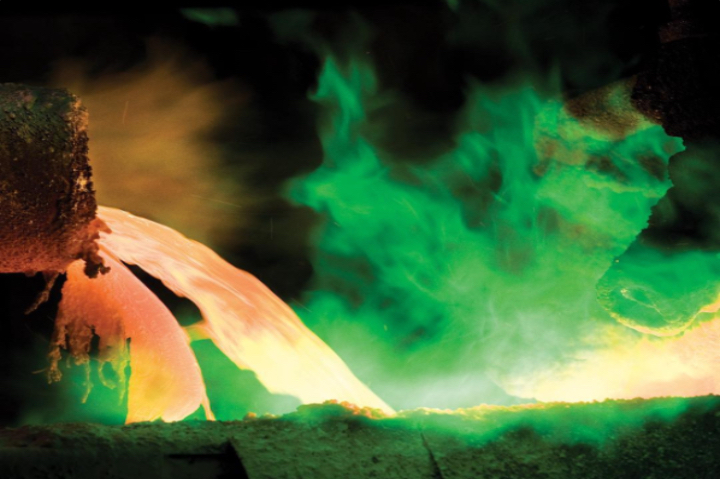
The metals industry is abuzz with a possible £31 billion ($39 billion) takeover of Anglo American Plc by Australian giant BHP Group Ltd. Anglo has rejected the offer arguing that it’s a significant undervaluation.
The deal, if it happens, would make BHP the world’s top producer of copper — a metal that’s desperately needed in greater quantities for a world that’s electrifying quickly. Copper can make all sorts of green solutions a reality, from building out power lines and transport to clean energy and electric car manufacturing. BloombergNEF calculates that, based on the way copper’s used today, reaching the world’s most ambitious climate goals would require a fourfold rise in consumption.
That’s all but impossible to reach so efficiency, recycling and substitution will all play a role, though supply will still have to rise sharply. CRU, a metals consultant, sees demand increasing about 40% by 2050 even if cleaner technologies aren’t rolled out aggressively.
All that expected growth has made copper more expensive. Prices are 50% higher today than they were before the pandemic. To avoid even more steep increases and the clean energy bottleneck that would come with them, there’s been a rush to find new technologies that can either boost the supply of copper or reduce its use.
Here are three ideas that could make a difference.
Copper is already in widespread use and increasing recycling rates could loosen the copper squeeze. More than 30% of all copper used between 2009 and 2019 was recycled, according to the International Copper Association. As products that use copper reach the end of their life, the opportunity for recyclers is likely to grow.
That, as well as the value of other minerals in batteries, has led to a new wave of high-tech recycling companies staking their claims. Among them is Redwood Materials, which is the biggest lithium-ion battery recycler in North America. Though copper only makes up a small portion of battery metals, Redwood is able to recover that alongside other more valuable metals.
Redwood has one machine operating at its Reno facility, which produces enough material to make 13,000 long-range EVs. By 2028, it plans to have 100 machines up and running. In addition to helping expand the copper supply chain, recycling also has the potential to reduce batteries’ carbon footprint.
The world is still at an early stage in the energy transition. That means the current rates of growth in copper demand can give a false impression of just how much demand there is likely to be in 30 years time.
Crucially, commodity traders have often found that the cure for high prices is substituting in cheaper alternatives where possible. “If elevated prices are sustained over the long term, we are going to see substitution to other metals like aluminum,” said Kwasi Ampofo, head of metals and mining at BNEF.
But opinions are divided on how much substitution is feasible. Substitution and reduction in use led to only about 1.8% decline in copper demand in 2023, according to DMM Advisory Group. On the other hand, the International Aluminum Institute estimates that swapping out copper in building wires and transformers could increase aluminum sales for those uses by 2% and 30% respectively.
Regardless of those debates, there’s one thing all sides agree on. “Copper demand is expected to grow,” said Ampofo.
One of the biggest increases in copper demand will be the result of moving from fossil fuel-powered cars to battery-powered cars. On average, an EV uses more than three times as much copper as its dirty cousin.
However, changing battery architecture can dramatically reduce copper use. Tesla’s Cybertruck uses 40% less copper than the comparable Ford’s F-150 Lightning. It does so thanks to a 48-volt architecture, which enables higher electric energy to flow without the need for as much copper cabling, relative to the traditional 12-volt architecture. But that technology remains at least a decade away from widespread adoption.
There are two ways to refine copper from raw ore. The most widely used technique is pyrometallurgy, essentially heating ore using fossil fuels to very high temperatures and extracting copper metal from it. The less widely used technique is hydrometallurgy, which involves treating ore with chemicals in water and using the selectivity of reactions to draw out copper.
Even though pyrometallurgy is more energy and carbon intensive, it’s typically the best solution for the most common types of copper ore. The startup Jetti Resources, which won a BNEF Pioneers award last year, claims that it has found a way to make hydrometallurgical copper extraction more efficient. It uses a catalyst to break down the less reactive materials in some types of abundant, lower-grade copper ore. That could raise extraction at existing deposits, but also pry copper from million of tons of waste already dug at existing mines.
The startup has raised more than $100 million — including from BHP — and deployed its technology at two mines. It now has more than 20 projects at various stages of development. If it proves successful, then it could increase copper supply using low-grade ore that was previously deemed economically unviable.
(By Akshat Rathi)
Comments